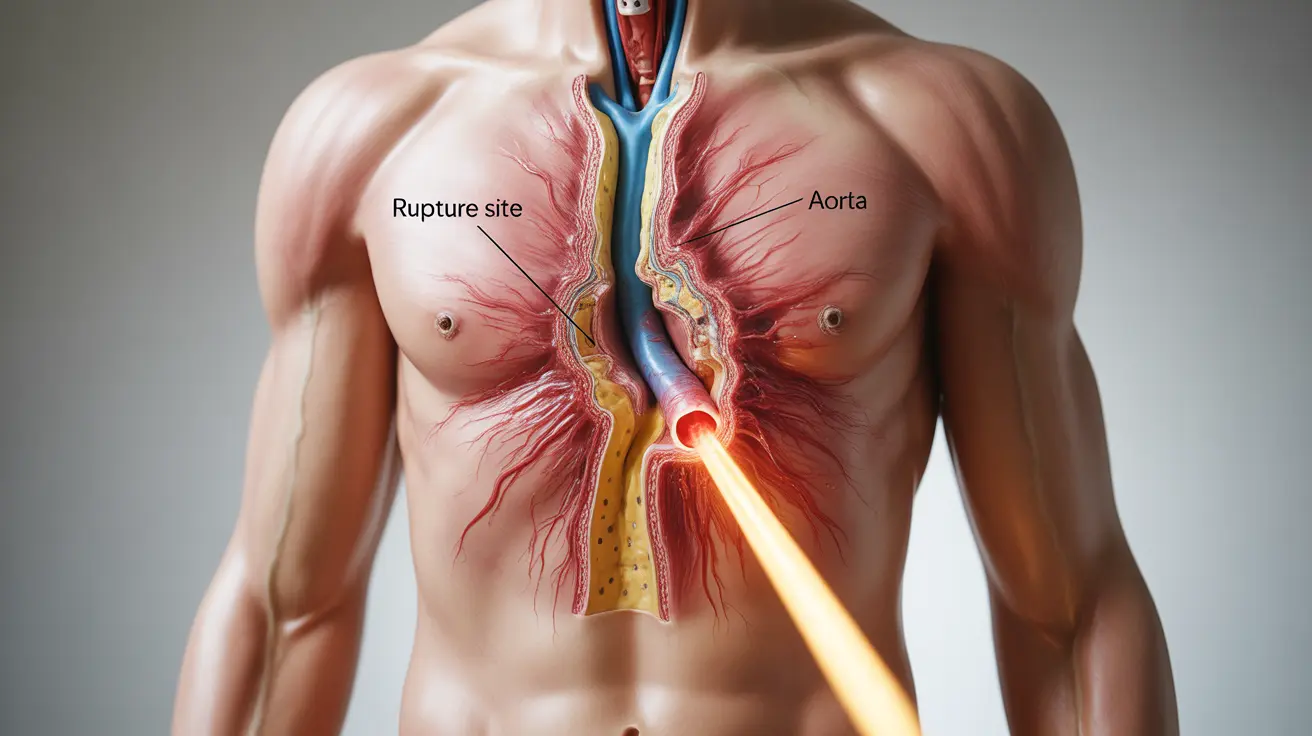A ruptured aortic aneurysm is a life-threatening medical emergency that requires immediate attention. This serious condition occurs when a weakened area of the aorta—the body's main artery—bursts, leading to severe internal bleeding. Understanding the warning signs, risk factors, and prevention strategies can be crucial for survival and risk reduction.
Early recognition of symptoms and immediate medical intervention are essential, as the mortality rate for ruptured aortic aneurysms is significantly high. This comprehensive guide will explore the critical aspects of this condition, from identifying warning signs to understanding treatment options and preventive measures.
Understanding Aortic Aneurysm Rupture
A ruptured aortic aneurysm occurs when the wall of a weakened, balloon-like bulge in the aorta suddenly breaks. This rupture allows blood to leak into surrounding tissues, creating a medical emergency that requires immediate surgical intervention. The location of the aneurysm—whether in the chest (thoracic) or abdomen (abdominal)—can affect both symptoms and treatment approaches.
Critical Warning Signs and Symptoms
Recognizing the symptoms of a ruptured aortic aneurysm is crucial for seeking timely medical care. The most common warning signs include:
- Sudden, severe chest or back pain, often described as tearing or ripping
- Severe abdominal pain that radiates to the back
- Rapid heart rate and difficulty breathing
- Dizziness or fainting
- Excessive sweating
- Low blood pressure
- Weakness or paralysis on one side of the body
- Loss of consciousness
Emergency Treatment Procedures
When a ruptured aortic aneurysm is suspected, emergency medical intervention is essential. Treatment typically involves:
Immediate Medical Response
Emergency responders focus on stabilizing vital signs and rapid transport to a hospital with vascular surgery capabilities.
Surgical Intervention
The primary treatment is emergency surgery, which may include:
- Traditional open surgery to repair the damaged aorta
- Endovascular repair using stent grafts
- Blood transfusions and fluid replacement
- Medication to control blood pressure and pain
Risk Factors and Prevention
Several factors can increase the risk of developing and rupturing an aortic aneurysm:
Major Risk Factors
- High blood pressure
- Smoking
- Age (typically over 65)
- Family history of aneurysms
- Atherosclerosis
- Genetic conditions affecting connective tissue
Preventive Measures
Taking proactive steps can help reduce the risk of developing or rupturing an aortic aneurysm:
- Maintain healthy blood pressure levels
- Quit smoking
- Regular exercise and maintaining a healthy weight
- Regular medical check-ups
- Managing cholesterol levels
- Following a heart-healthy diet
Screening Guidelines
Certain individuals should consider regular screening for aortic aneurysms, particularly:
- Men aged 65-75 who have ever smoked
- People with a family history of aortic aneurysms
- Those with genetic conditions that increase risk
- Individuals with high blood pressure or heart disease
Frequently Asked Questions
What are the warning signs and symptoms of a ruptured aortic aneurysm?
The primary warning signs include sudden, severe chest or back pain, intense abdominal pain, difficulty breathing, dizziness, rapid heart rate, and loss of consciousness. These symptoms typically appear suddenly and require immediate emergency medical attention.
How is a ruptured aortic aneurysm treated in an emergency?
Emergency treatment involves immediate surgery, either through traditional open surgery or endovascular repair, along with blood pressure management, fluid replacement, and blood transfusions as needed. The specific approach depends on the location and extent of the rupture.
What are the main risk factors that increase the chance of an aortic aneurysm rupturing?
Major risk factors include high blood pressure, smoking, advanced age, family history, atherosclerosis, and certain genetic conditions. The larger the aneurysm grows, the higher the risk of rupture becomes.
How can I prevent or reduce the risk of having a ruptured aortic aneurysm?
Prevention strategies include maintaining healthy blood pressure, quitting smoking, regular exercise, managing cholesterol levels, following a heart-healthy diet, and getting regular medical check-ups. Those with risk factors should discuss screening options with their healthcare provider.
When should someone get screened for an aortic aneurysm before it ruptures?
Screening is recommended for men aged 65-75 who have ever smoked, individuals with a family history of aortic aneurysms, those with genetic risk factors, and people with conditions like high blood pressure or heart disease. Your doctor can help determine the appropriate screening schedule based on your risk factors.




